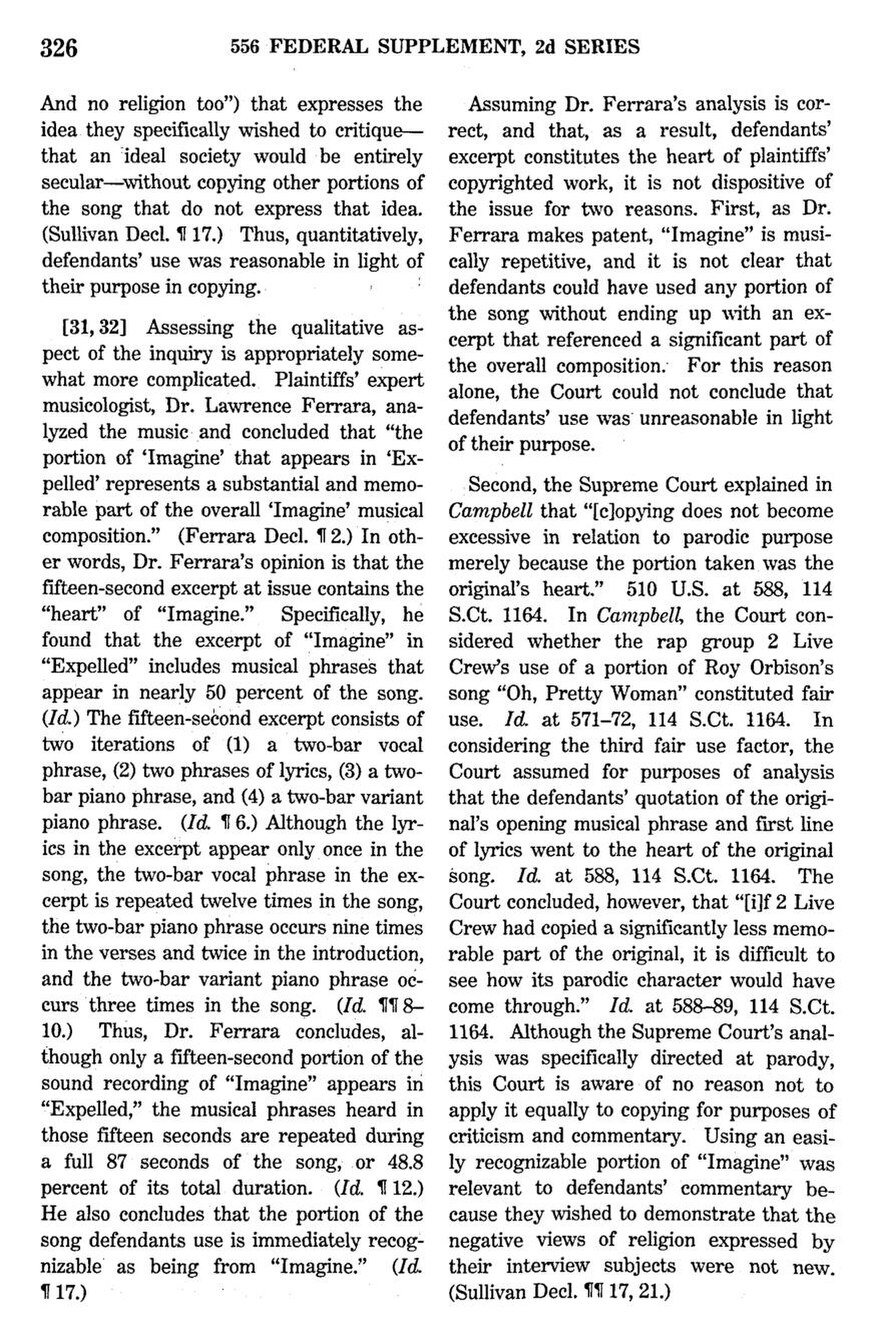And no religion too”) that expresses the idea they specifically wished to critique—that an ideal society would be entirely secular—without copying other portions of the song that do not express that idea. (Sullivan Decl. ¶ 17.) Thus, quantitatively, defendants’ use was reasonable in light of their purpose in copying.
Assessing the qualitative aspect of the inquiry is appropriately somewhat more complicated. Plaintiffs’ expert musicologist, Dr. Lawrence Ferrara, analyzed the music and concluded that “the portion of ‘Imagine’ that appears in ‘Expelled’ represents a substantial and memorable part of the overall ‘Imagine’ musical composition.” (Ferrara Decl. ¶ 2.) In other words, Dr. Ferrara’s opinion is that the fifteen-second excerpt at issue contains the “heart” of “Imagine.” Specifically, he found that the excerpt of “Imagine” in “Expelled” includes musical phrases that appear in nearly 50 percent of the song. (Id.) The fifteen-second excerpt consists of two iterations of (1) a two-bar vocal phrase, (2) two phrases of lyrics, (3) a two-bar piano phrase, and (4) a two-bar variant piano phrase. (Id. ¶ 6.) Although the lyrics in the excerpt appear only once in the song, the two-bar vocal phrase in the excerpt is repeated twelve times in the song, the two-bar piano phrase occurs nine times in the verses and twice in the introduction, and the two-bar variant piano phrase occurs three times in the song. (Id. ¶¶ 8-10.) Thus, Dr. Ferrara concludes, although only a fifteen-second portion of the sound recording of “Imagine” appears in “Expelled,” the musical phrases heard in those fifteen seconds are repeated during a full 87 seconds of the song, or 48.8 percent of its total duration. (Id. ¶ 12.) He also concludes that the portion of the song defendants use is immediately recognizable as being from “Imagine.” (Id. ¶ 17.)
Assuming Dr. Ferrara’s analysis is correct, and that, as a result, defendants’ excerpt constitutes the heart of plaintiffs’ copyrighted work, it is not dispositive of the issue for two reasons. First, as Dr. Ferrara makes patent, “Imagine” is musically repetitive, and it is not clear that defendants could have used any portion of the song without ending up with an excerpt that referenced a significant part of the overall composition. For this reason alone, the Court could not conclude that defendants’ use was unreasonable in light of their purpose.
Second, the Supreme Court explained in Campbell that “[c]opying does not become excessive in relation to a parodic purpose merely because the portion taken was the original’s heart.” 510 U.S. at 588, 114 S.Ct. 1164. In Campbell, the Court considered whether the rap group 2 Live Crew’s use of a portion of Roy Orbison’s song “Oh, Pretty Woman” constituted fair use. Id. at 571-72, 114 S.Ct. 1164. In considering the third fair use factor, the Court assumed for purposes of analysis that the defendants’ quotation of the original’s opening musical phrase and first line of lyrics went to the heart of the original song. Id. at 588, 114 S.Ct. 1164. The Court concluded, however, that “[i]f 2 Live Crew had copied a significantly less memorable part of the original, it is difficult to see how its parodic character would have come through.” Id. at 588-89, 114 S.Ct. 1164. Although the Supreme Court’s analysis was specifically directed at parody, this Court is aware of no reason not to apply it equally to copying for purposes of criticism and commentary. Using an easily recognizable portion of “Imagine” was relevant to defendants’ commentary because they wished to demonstrate that the negative views of religion expressed by their interview subjects were not new. (Sullivan Decl. ¶¶ 17, 21.)
